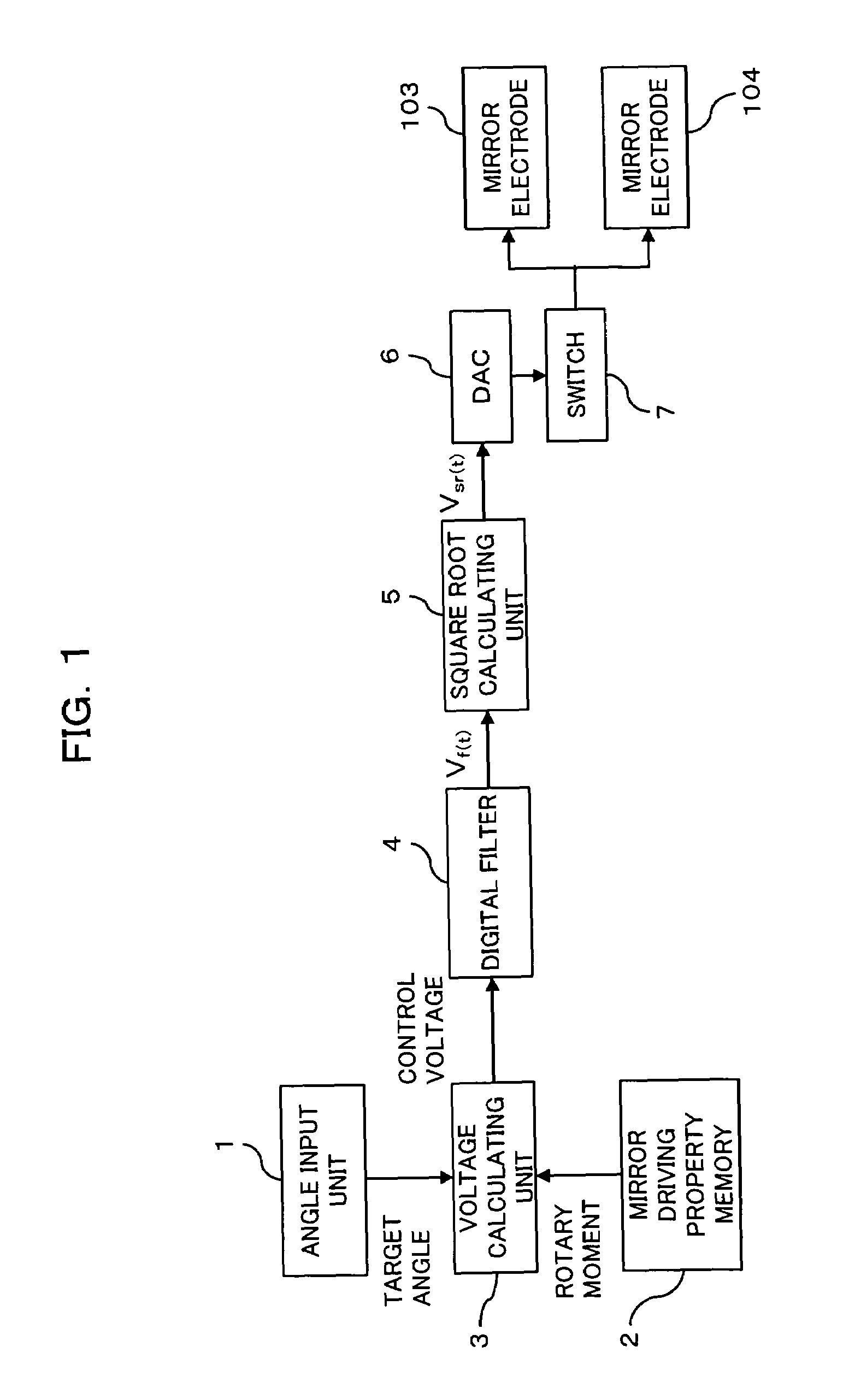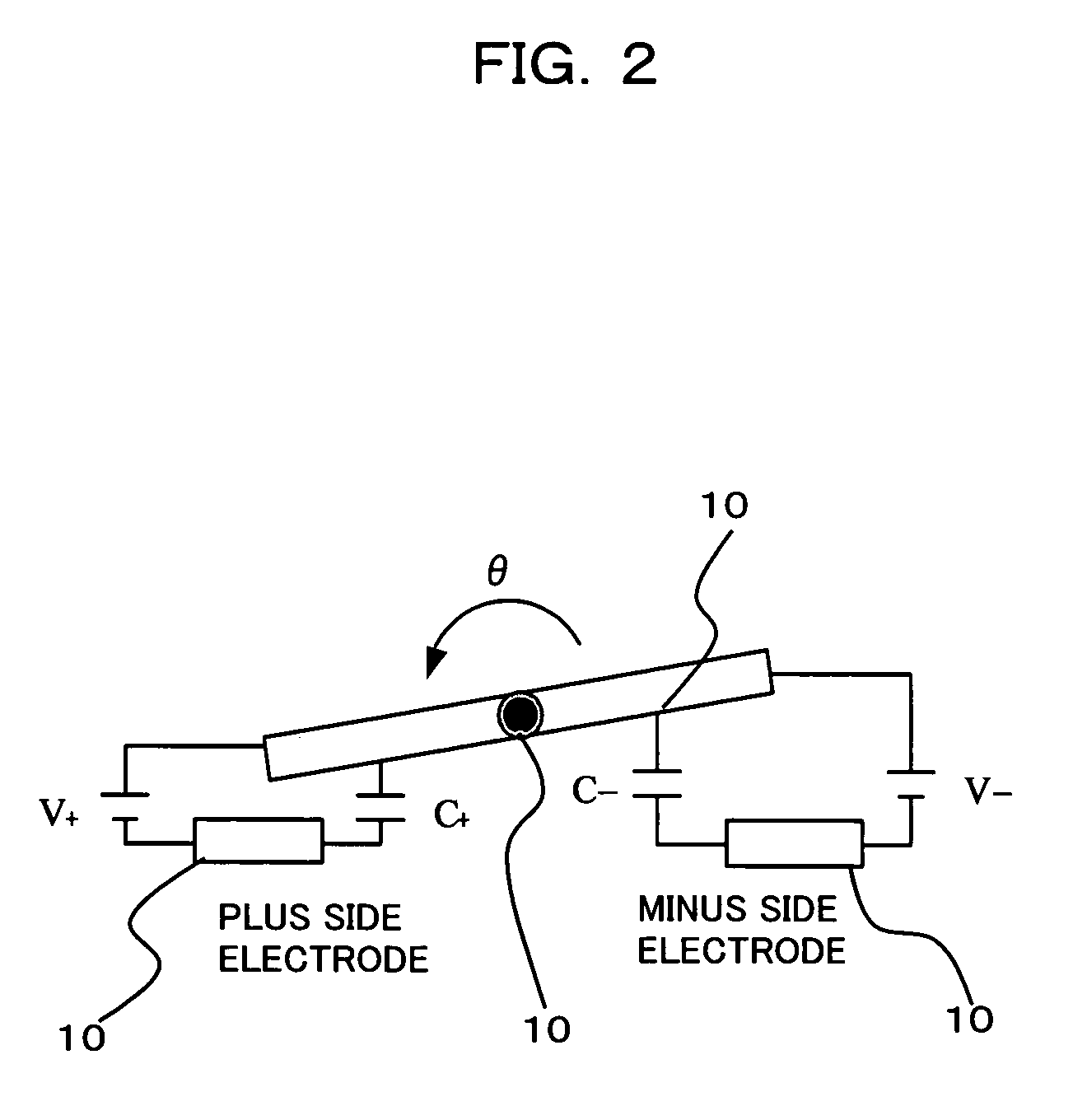Tilt mirror controlling apparatus and method
a technology of tilt mirror and control apparatus, which is applied in the direction of optics, instruments, optics, etc., can solve the problems of difficult control of significant non-linearity due to voltage square term, non-linearity of electrostatic capacity, and often becomes a problem, etc., to achieve stable control, facilitate control of target angle and various parameters, and stable angle response
- Summary
- Abstract
- Description
- Claims
- Application Information
AI Technical Summary
Benefits of technology
Problems solved by technology
Method used
Image
Examples
first embodiment
[0058][1]
[0059]FIG. 1 schematically shows a tilt mirror control apparatus according to a first embodiment of the present invention. The control apparatus, for example, controls a tilt angle of the tilt mirror 102 already described with reference to FIG. 13. In the present embodiment, as shown in FIG. 1, the control apparatus has an angle input unit 1, a mirror driving property memory 2, a voltage calculating unit 3, a digital filter 4, a square root calculating unit 5, a digital to analog converter (DAC) 6, and a switch 7. Items 103 and 104 are electrodes (a plus-side electrode and a minus-side electrode) placed under the tilt mirror 102. Those electrodes are symmetrically disposed with respect to a rotation axis (torsion bar) 101 (see FIG. 13) of the tilt mirror 102.
[0060]The angle input unit 1 inputs a target tilt angle of the tilt mirror 102 as a parameter; the mirror driving property memory 2 stores, in advance, information (hereinafter called “driving property information”) abo...
second embodiment
[0082][2]
[0083]A second embodiment of the present invention aims to realize mirror controlling even speedier and more stable than the above first embodiment. In mirror control according to the first embodiment, there is no denying that it is still difficult to completely compensate for effects given from the non-linearity [angular dependency of the following equation (C-1)
∂C / ∂θ (C-1)
in the right side of the foregoing formula (1)] of electrostatic capacities against mirror rotation angles (tilt angles). It thus cannot be said that a residual resonance frequency is suppressed truly sufficiently.
[0084]This is because, in the first embodiment (or the conventional art), α, expressed by the formula (A-10), is regarded as a constant. As shown in FIG. 5, for example, there appears deviation (see the broken line 13 and the solid line 14) between the angular differentiation of the mirror electrostatic capacity against the mirror rotation angle and an ideal characteristic. In the second embod...
third embodiment
[0100][C]
[0101]The foregoing formula (C-4) can be expressed as θα(θ)=θmaxVcmaxVcα(θmaxVcmaxVc)(D-1)
Thus, it can be approximated as θ=θmaxVcmaxVc(D-2)
That is, θ∝Vc. This relational expression goes for where θc is obtained. In the above example, however, a non-linear rate of change in capacity is compensated for by assuming that “the mirror 102 is in a state of equilibrium” [using the foregoing kinetic equations (A-2) and (A-3), where the equations (A-4) and (A-5) are satisfied and where θ>0 and V>0]. Thus, if a voltage such that the equilibrium is disturbed is applied, or if the voltage is changed so fast that the mirror 102 cannot respond thereto in changing its angles, the above approximation cannot be established.
[0102]This causes distortion of an electrostatic torque, thereby inducing an occurrence of resonance. In particular, when high-speed step driving is performed, a short-pulse-like voltage needs to be initially applied, resulting sometimes in marked torque distorti...
PUM
 Login to View More
Login to View More Abstract
Description
Claims
Application Information
 Login to View More
Login to View More - R&D
- Intellectual Property
- Life Sciences
- Materials
- Tech Scout
- Unparalleled Data Quality
- Higher Quality Content
- 60% Fewer Hallucinations
Browse by: Latest US Patents, China's latest patents, Technical Efficacy Thesaurus, Application Domain, Technology Topic, Popular Technical Reports.
© 2025 PatSnap. All rights reserved.Legal|Privacy policy|Modern Slavery Act Transparency Statement|Sitemap|About US| Contact US: help@patsnap.com



